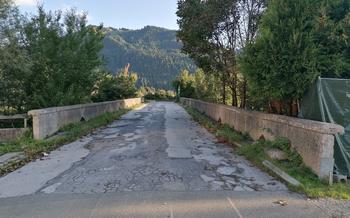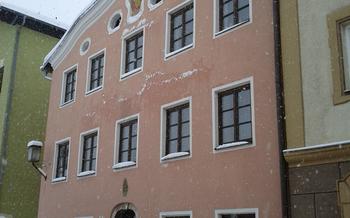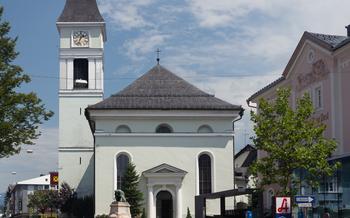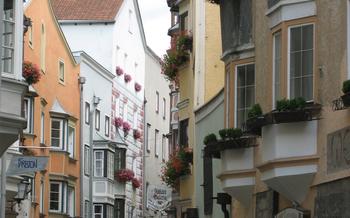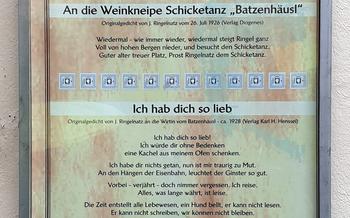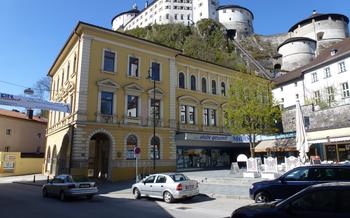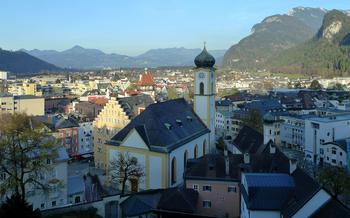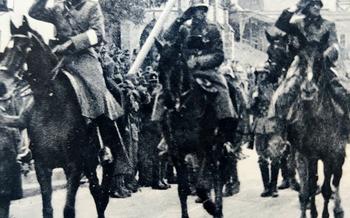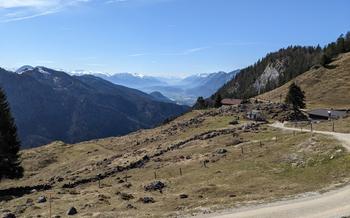
St. Vitus and St. Nicholas Parish Church
- Atop the Hill: A Journey to St. Vitus and St. Nicholas Parish Church
- Architectural Masterpiece: Unveiling the Church's Design
- The Legend of St. Vitus: A Tale of Faith and Courage
- A Place of Worship and Community: The Church's Significance
- Unveiling the Interior: A Treasure Trove of Art and History
- A Haven for Reflection: The Church's Spiritual Atmosphere
- Exploring the Surroundings: Kufstein's Rich Heritage
- Events and Festivals: Celebrating Faith and Community
- The Church's Contribution to the Community
- Hidden Gems: Discovering Lesser-Known Aspects of the Church
- Inspiring Literature and Art: The Church's Influence
- Insider Tip: Unveiling the Secret Viewpoint
Atop the Hill: A Journey to St. Vitus and St. Nicholas Parish Church
Nestled atop a hill overlooking the picturesque town of Kufstein, Austria, stands the magnificent St. Vitus and St. Nicholas Parish Church, a testament to the region's rich history and architectural prowess. With its soaring spires piercing the sky and intricate Gothic details adorning its facade, the church invites visitors to embark on a journey through time, uncovering its secrets and marveling at its grandeur.
St. Vitus and St. Nicholas Parish Church holds a significant place in the heart of Kufstein, serving as a spiritual and cultural landmark for centuries. Its origins can be traced back to the 14th century, when a small chapel stood on the site. Over time, the chapel underwent several expansions and renovations, culminating in the construction of the current church in the 15th century.
The church is dedicated to two saints who hold special significance in the region. St. Vitus, a young martyr who remained steadfast in his faith despite persecution, is revered for his courage and resilience. St. Nicholas, known for his generosity and kindness, is a beloved figure associated with gift-giving and the spirit of Christmas.
The legend of St. Vitus is deeply intertwined with the history of the church. According to local lore, St. Vitus appeared to a local shepherd on the hilltop, instructing him to build a chapel in his honor. The shepherd obeyed, and the chapel eventually evolved into the grand church that stands today.
Visitors to St. Vitus and St. Nicholas Parish Church are welcomed by a sense of awe and tranquility. The church's doors are open to all, inviting them to explore its sacred spaces and discover the stories they hold. Whether you're a history buff, an architecture enthusiast, or simply seeking a moment of peace and reflection, this magnificent church promises an unforgettable experience.
Architectural Masterpiece: Unveiling the Church's Design
The St. Vitus and St. Nicholas Parish Church stands as a testament to the architectural brilliance of the Gothic period. Its exterior facade captivates with intricate details, pointed arches, and flying buttresses that create a sense of height and elegance. The church's unique features include a distinctive onion-shaped dome, a symbol of Tyrolean architecture, and a slender spire that reaches towards the heavens.
Stepping inside, visitors are greeted by a breathtaking interior that showcases the Gothic style in all its glory. The ribbed vaults soar overhead, creating a sense of awe and grandeur. The intricate details of the stone carvings, depicting biblical scenes and mythical creatures, add to the church's charm. The stained glass windows, with their vibrant hues and intricate designs, cast a warm and colorful light, illuminating the sacred space.
The church's interior is adorned with a collection of remarkable artwork. The altarpieces, with their intricate carvings and paintings, depict scenes from the lives of saints and biblical stories. The sculptures, scattered throughout the church, add a sense of depth and realism to the sacred space. The frescoes, with their faded colors and delicate brushstrokes, offer a glimpse into the artistic traditions of the past.
Comparisons with other notable Gothic churches in the region reveal the unique characteristics of St. Vitus and St. Nicholas Parish Church. While it shares similarities with other Gothic structures, such as the use of pointed arches and ribbed vaults, it stands out with its distinctive onion-shaped dome and the blend of Gothic and Tyrolean architectural elements.
The Legend of St. Vitus: A Tale of Faith and Courage
St. Vitus, a young Christian martyr, holds a special place in the history and legend of Kufstein. Born to a noble family in Sicily around the year 290 AD, Vitus dedicated his life to Christ from a young age. When his father tried to force him to renounce his faith, Vitus fled with his tutor, Modestus, and his nurse, Crescentia, to escape persecution.
Along their journey, they encountered numerous challenges and trials, but Vitus remained steadfast in his faith. In one instance, they were captured by a Roman governor and thrown into a boiling cauldron of oil. Miraculously, they emerged unscathed, leading to the governor's conversion to Christianity.
Vitus's fame as a healer and miracle worker spread throughout the land, attracting many followers. However, his refusal to renounce his faith angered the Roman authorities, who eventually arrested and imprisoned him. Despite enduring torture and imprisonment, Vitus remained unwavering in his devotion to God.
According to legend, Vitus was eventually martyred by being thrown into a river with a millstone tied around his neck. However, angels intervened, and his body was miraculously transported to Kufstein, where he was buried. The town of Kufstein adopted St. Vitus as its patron saint, and the church dedicated to him stands as a testament to his unwavering faith and courage in the face of adversity.
A Place of Worship and Community: The Church's Significance
St. Vitus and St. Nicholas Parish Church stands as a cornerstone of religious life in Kufstein. For centuries, it has served as a place of worship, gathering, and spiritual nourishment for the local community. The church's grand interior provides a sacred space for various religious ceremonies, including masses, baptisms, weddings, and funerals. Throughout the year, the church hosts a diverse range of events and services that cater to the spiritual needs of its congregation. These events include choir concerts, Bible study groups, youth gatherings, and charitable initiatives.
Beyond its religious significance, the church fosters a deep sense of community and belonging among the people of Kufstein. It serves as a meeting point, a place where individuals can come together to celebrate, mourn, and share their lives. The church's doors are always open, welcoming visitors and locals alike to seek solace, guidance, and a sense of connection. Whether through attending services, participating in community events, or simply finding a quiet moment for reflection, St. Vitus and St. Nicholas Parish Church plays a vital role in enriching the lives of the Kufstein community.
Personal experiences and reflections add depth to this section. Share your own story of attending a service or event at the church, or describe the sense of peace and belonging you felt within its walls. These personal anecdotes help readers connect with the church's significance on a deeper level.
Unveiling the Interior: A Treasure Trove of Art and History
Stepping inside St. Vitus and St. Nicholas Parish Church is like entering a sacred museum, where every corner holds a masterpiece. The intricate altarpieces, with their meticulously carved figures and gleaming gold leaf, narrate biblical stories with stunning detail. The expressive sculptures, frozen in moments of devotion or suffering, seem to breathe life into the stone. The vibrant frescoes, with their celestial hues and allegorical scenes, transport visitors to a realm of divine beauty.
Among the highlights of the church's interior is the magnificent high altar, a masterpiece of Gothic artistry. Its central panel depicts the crucifixion of Jesus Christ, flanked by intricately carved figures of saints and angels. The side panels, adorned with scenes from the life of the Virgin Mary, add to the altar's grandeur. The intricate details and symbolic motifs found throughout the altar offer a glimpse into the minds of medieval craftsmen and the deep theological significance they embedded in their work.
The stained glass windows, with their brilliant colors and delicate tracery, cast a kaleidoscope of light onto the church's interior, creating a mystical atmosphere. Each window tells a story from the Bible or the lives of the saints, inviting visitors to contemplate their spiritual significance. The overall effect of the church's interior is one of awe and inspiration, a testament to the enduring power of faith and the artistic genius of its creators.
A Haven for Reflection: The Church's Spiritual Atmosphere
Amidst the bustling streets of Kufstein, St. Vitus and St. Nicholas Parish Church stands as a sanctuary of tranquility and spiritual reflection. Stepping inside, visitors are enveloped by a palpable sense of peace and serenity. The soft glow of candlelight illuminates the sacred space, casting an ethereal glow on the intricate artwork and stained glass windows.
The church's interior invites contemplation and introspection. Rows of wooden pews, worn smooth by generations of worshippers, beckon visitors to pause and find a moment of solace. The absence of intrusive noise amplifies the church's sacred ambiance, allowing for a deep connection with one's inner self.
As visitors wander through the church, they are reminded of the enduring power of faith and spirituality. The intricate carvings, frescoes, and sculptures depict biblical scenes and saints, offering a glimpse into the rich history of Christianity. The church's serene atmosphere encourages visitors to slow down, appreciate the beauty around them, and connect with the divine.
Whether seeking a moment of respite from the outside world or seeking spiritual nourishment, St. Vitus and St. Nicholas Parish Church offers a haven for reflection and renewal. It is a place where visitors can find solace, peace, and inspiration, leaving with a renewed sense of purpose and connection to the divine.
Exploring the Surroundings: Kufstein's Rich Heritage
Nestled in the heart of the Tyrolean Alps, Kufstein is a treasure trove of history and natural beauty. Beyond the walls of St. Vitus and St. Nicholas Parish Church, the town unveils a tapestry of rich heritage and captivating attractions. Embark on a journey through time as you wander the cobblestone streets, discovering architectural wonders and stories that have shaped Kufstein's unique identity.
Kufstein Fortress, a majestic symbol of the town's resilience, stands guard over the Inn Valley. Explore its ramparts, dungeons, and museums to delve into the fascinating history of this medieval stronghold. The Römerhofgasse, a picturesque alley lined with colorful facades, transports you back to the Middle Ages, where merchants and artisans once plied their trade.
Immerse yourself in art and culture at the Kufstein Gallery, showcasing a diverse collection of contemporary and modern artworks. For a taste of local history, visit the Heimatmuseum Kufstein, where exhibits bring to life the town's traditions, customs, and way of life.
Nature lovers will find solace in the pristine landscapes surrounding Kufstein. Embark on a leisurely hike or bike ride along the Inn River, taking in the breathtaking views of the Tyrolean Alps. Ascend to the top of the Kaiserlift cable car for panoramic vistas that will leave you breathless.
Indulge in the local cuisine at one of Kufstein's many charming restaurants and cafes. Savor Tyrolean specialties like Käsespätzle (cheese noodles) and Tiroler Gröstl (fried potatoes with meat and onions), accompanied by a refreshing glass of beer or wine.
Kufstein's vibrant calendar of events adds to its allure. Don't miss the annual Kufstein Festival, a month-long celebration of music and theater that attracts visitors from far and wide. The Christmas Market, with its enchanting stalls and festive atmosphere, is a magical experience that will warm your heart.
Whether you seek history, culture, or natural beauty, Kufstein has something to offer every traveler. Its rich heritage and warm Tyrolean hospitality will leave you with unforgettable memories.
Events and Festivals: Celebrating Faith and Community
The St. Vitus and St. Nicholas Parish Church is not only a place of worship but also a vibrant hub for community events and festivals. Throughout the year, the church hosts a variety of religious celebrations and gatherings that bring together the local community.
One of the most significant events is the annual patron saint's feast day, which honors St. Vitus on June 15th. This day is marked by a festive mass, processions, and traditional music performances. Locals dress in traditional attire and participate in a lively parade through the streets of Kufstein, showcasing their devotion to their patron saint.
During the Christmas season, the church transforms into a magical winter wonderland. The exterior is adorned with twinkling lights, and the interior is filled with festive decorations. Special Christmas masses, concerts, and nativity plays are held, creating a warm and welcoming atmosphere for all.
Easter is another important time for the church, as it celebrates the resurrection of Jesus Christ. During Holy Week, special services, processions, and reenactments of the Passion of Christ take place, culminating in the Easter Sunday mass, which is attended by many faithful from Kufstein and beyond.
These events and festivals are not just religious celebrations but also opportunities for the community to come together, socialize, and strengthen their bonds. They provide a sense of belonging and shared identity, making the St. Vitus and St. Nicholas Parish Church a vital part of Kufstein's cultural and spiritual heritage.
The Church's Contribution to the Community
Beyond its religious significance, St. Vitus and St. Nicholas Parish Church plays a vital role in the community of Kufstein. The church actively engages in social and charitable initiatives, demonstrating its commitment to the well-being of its members and the broader society.
One of the church's primary focuses is supporting those in need. It operates a soup kitchen that provides meals to the homeless and disadvantaged, offering them a warm and welcoming space to come together and receive nourishment. The church also organizes regular food drives and clothing collections to assist families struggling to make ends meet.
Additionally, the church is deeply involved in youth work. It runs a youth club that provides a safe and supportive environment for young people to socialize, learn, and grow. The club offers a range of activities, including sports, arts and crafts, and educational workshops, helping to keep young people engaged and away from negative influences.
Furthermore, the church actively promotes interfaith dialogue and cooperation. It hosts regular events and workshops that bring together people of different faiths to foster understanding and respect. By creating a platform for open dialogue, the church helps to break down barriers and build bridges between different communities.
These initiatives and programs demonstrate the church's commitment to serving the community beyond its religious duties. By providing practical assistance, supporting the youth, and promoting interfaith harmony, St. Vitus and St. Nicholas Parish Church plays a crucial role in strengthening the fabric of Kufstein's society.
Hidden Gems: Discovering Lesser-Known Aspects of the Church
Beyond its iconic facade and well-known stories, St. Vitus and St. Nicholas Parish Church holds a treasure trove of hidden gems waiting to be discovered. One such gem is the intricate sundial meticulously carved into the exterior wall. Often overlooked by visitors, this sundial serves as a testament to the church's rich history and connection to astronomy. Its unique design and precise markings reveal the ingenuity and craftsmanship of its creators.
Venturing inside the church, one can find a hidden chamber known as the sacristy. This sacred space, typically reserved for clergy, offers a glimpse into the inner workings of the church. Here, visitors can admire the ornate vestments, intricately crafted liturgical vessels, and ancient books that have been carefully preserved over the centuries. The sacristy provides a profound sense of the church's ongoing spiritual significance and the dedication of its caretakers.
Another hidden gem lies beneath the church's floor. Descending into the crypt, visitors can explore a series of underground chambers that once served as a burial ground for prominent figures from Kufstein's past. The crypt's eerie atmosphere and well-preserved tombs offer a unique perspective on the town's history and the lives of its former residents.
Inspiring Literature and Art: The Church's Influence
The allure of St. Vitus and St. Nicholas Parish Church has extended beyond its physical presence, inspiring numerous works of literature and art. The church's imposing architecture and rich history have captured the imagination of poets, painters, and writers alike, who have found endless inspiration within its walls.
One of the most notable literary works inspired by the church is the poem "Kufstein" by Austrian poet Josef Weinheber. In his poem, Weinheber paints a vivid picture of the church, describing its towering steeple and the surrounding landscape. He captures the essence of the church's spiritual significance, portraying it as a symbol of hope and resilience for the people of Kufstein.
The church has also been immortalized in paintings by renowned artists such as Albin Egger-Lienz and Alfons Walde. Egger-Lienz's painting "Kufstein" depicts the church as a focal point of the town, surrounded by the Tyrolean Alps. Walde's painting "St. Vitus Church" captures the church's Gothic beauty, with its intricate details and delicate spires reaching towards the heavens.
The influence of the church can also be found in contemporary art forms. Local photographers often use the church as a backdrop for their work, capturing its stunning architecture and the surrounding scenery. The church's unique atmosphere has also inspired musicians and filmmakers to create works that reflect its spiritual and historical significance.
Exploring the literary and artistic works inspired by St. Vitus and St. Nicholas Parish Church offers a deeper appreciation for its cultural and historical importance. These works provide a glimpse into the minds of those who have been touched by the church's beauty and grandeur, allowing visitors to experience the church from a different perspective.
Insider Tip: Unveiling the Secret Viewpoint
Beyond the church's captivating facade and intricate interior lies a hidden gem waiting to be discovered. A secret viewpoint, tucked away from the bustling streets of Kufstein, offers a unique perspective that unveils the church's grandeur and its harmonious relationship with the surrounding landscape.
To find this hidden treasure, wander along the winding cobblestone streets that lead away from the church square. As you approach the edge of the old town, keep an eye out for a discreet archway nestled between two charming Tyrolean houses. Step through the archway and follow the narrow path that winds its way up the hill.
As you ascend, the town's rooftops and the distant peaks of the Kaisergebirge Mountains come into view. But the true spectacle awaits at the top of the hill. Here, a small clearing reveals a breathtaking panorama of St. Vitus and St. Nicholas Parish Church.
The church's imposing Gothic spires soar towards the sky, framed by the lush greenery of the surrounding hills. The play of light and shadow on its weathered stone facade creates a captivating effect, making it a photographer's paradise.
Whether you're an early bird chasing the golden hues of dawn or a sunset seeker captivated by the warm glow of dusk, this secret viewpoint offers a magical experience. Capture the church's timeless beauty against the backdrop of a vibrant sky, and cherish the memory of this hidden gem for years to come.
